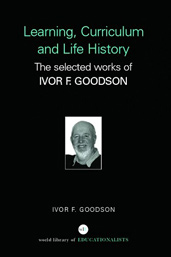Learning, Curriculum and Life Politics: the selected works of Ivor F. Goodson
Becoming a School Subject
The messianic nature of their appeal is shown when they argue that it is:
Better that geography should explode in an excess of reform than bask in the watery sunset of its former glories; for in an age of rising standards in school and university, to maintain the present standards is not enough - to stand still is to retreat, to move forward hesitantly is to fall back from the frontier. If we move with that frontier new horizons emerge in our view, and we find new territories to be explored as exciting and demanding as the dark continents that beckoned any earlier generation of geographers. This is the teaching frontier of geography.
The Madingley Lectures proved a watershed in the emergence of the subject. Two years before, E.E. Gilbert - in an article on 'The Idea of the Region' - had stated that he regarded new geography in the universities as an 'esoteric cult'. After Madingley, this was no longer the case, as a college lecturer who was secretary of his local Geographical Association recalled: 'After Madingley my ideas were turned upside down... That's where the turn around in thinking in geography really started'. But as Walford later noted, Madingley was 'heady to some, undrinkable brew to others'. Following the second Madingley Conference in 1968, Chorley and Haggett sought to consolidate the changes they were advocating by a new book entitled Models in Geography. By this time opinions were becoming progressively polarized about the 'new geography'. Slaymaker wrote in support of the book:
In retrospect, a turning point in the development of geographical methodology in Britain. After the exploratory and mildly iconoclastic contents of the first Madingley lectures, recorded in Frontiers in Geographical Teaching, a more substantial statement of the methodological basis and aims of the so-called 'new geography' was required... with the publication of this book [it is demonstrated that] the traditional classificatory paradigm is inadequate and that in the context of the 'new geography' an irreversible step has been taken to push us back into the mainstream of scientific activity by process of model building. The discussion of the relevance of new conceptual models in geographical research and teaching should serve as a stimulus to participation in methodological debate to which, with notable exceptions, British geographers have made a disproportionately small contribution. It is therefore a major publication, both in achievement and potential.
- Gilbert, E.W. (1961) 'The idea of the region', Geography, 45, No. 1.
- Personal Interview College of Education Lecturer, (5.1.77).
- Walford, R. (1973) 'Models, simulations and games', in R. Walford (Ed) op. cit., p. 95.
- Chorely, R. and Haggett, P. (1967) Models in Geography, London: Methuen.
- Slaymaker, O. (1960) 'Review', Geographical Journal, 134, Part 2, September.
